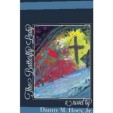Like some of the best music, The Butterfly Lady, Danny M. Hoey, Jr.’s début novel, is a study in unfulfilled desires, which have the power to haunt us as nothing else can. And like a musician who plays from his heart, Hoey brings to life the pull of such desires, and the hazards that lie on the paths to their fulfillment.
The novel opens with the murder of its central character, Gabriel Smith—a cross-dresser self-named the Butterfly Lady–in Cleveland in July 1983. As spectators watch morgue workers remove Gabriel’s body from the murder scene, “[t]hey were comforted with the understanding that there would be no investigation, no questions asked. No. It was a black man in a dress. Dead. Long ago dead to a world that turned off its light to him years before they stood, with slight satisfaction, and watched his body rolled out.”
From here, the novel moves back in time to explore why the world turned off its light to Gabriel and how, up until the time of his murder, he kept his own light brightly burning, in spite of others’ efforts to distance themselves from it or snuff it out entirely. In an early act of self-preservation, Gabriel escapes to Cleveland from Pittsburgh, after his father, a church deacon, blames the sudden death of his wife, Gabriel’s mother, on the shock of discovering her son in full make-up and a blond wig.
In Cleveland, Gabriel works at—and lives above—the store run by Mrs. Lilly Lee, whose criticism and teasing of Gabriel nearly equal her affection for him. This criticism, and Gabriel’s reaction to it, shed light on his predicament not only as a black man, but as a black man who wears dresses and makeup. In an early scene when Mrs. Lee chides Gabriel for looking “like a clown,” he replies
“This is America. You have a democracy. You can be who you want to be. Stop hiding.”
“Democracy? A white woman wearing two-hundred-dollar pumps in a white fur coat in the middle of summer, that’s democracy. A white man in Washington arguing to make his pockets bigger, that’s democracy. But a black man? A black man in Washington fighting for his rights is a crime, an affront against the white man’s soul. A black man in a dress? Now that’s a shame because white men love it and want to hide the fact that they do, and black people despise it and try their best not to claim it, to run as far away from it as they can. Then, when they can’t hide from it or when it’s in the very place they say can’t be touched or broken, they create this rope called Jesus and hang you with it. My neck is sore. Why hide? It’s not hiding—it’s survival.”
Living across the hall from Gabriel are Virginia and her son, Chance, who continually mourn the absence of Virginia’s lover, LeRoi, a traveling guitarist. LeRoi is incapable of commitment Virginia and Chance, who has been abandoned not only by his father but also by his mother. Hoey writes, “Virginia was lonely when LeRoi was gone, and having only her son to look at when he was gone was not enough. She didn’t even like Chance.”
But Gabriel does care about Chance. As he says to Mrs. Lee, Chance “[b]een my business since the day Virginia’s water broke all over my pumps.” It is Gabriel who tries to protect Virginia and Chance from the hazard and heartbreak of LeRoi, an effort that ultimately results in Gabriel’s murder.
Though this murder may be the most dramatic event of the novel, its greatest tragedy is the accumulation of unfulfilled desires: Gabriel’s for the affection of his parents, and for the welfare of Virginia and Chance; Virginia’s (and Chance’s) for a commitment from LeRoi; Mrs. Lee’s, for the protection of Gabriel, not only from Virginia and LeRoi but from a young man she fears will break Gabriel’s heart; and, finally, LeRoi’s, for the mother who abandoned him years before.
One of the most powerful aspects of the novel is the way in which Hoey steps into the shoes of each character and gives each of them a fair, honest hearing—even if their actions and beliefs are distasteful, even repellant. Take Gabriel’s father, Amos—“a Deacon not yet fire-baptized.” Early on, he excoriates Gabriel for his cross-dressing and asks him, “You want God to punish me for letting you be a sissy?” Years later, however, when Amos is dying, he reflects on the ways in which he disappointed his own father and acknowledges his limitations where Gabriel is concerned:
Hoey also provides some of LeRoi’s back story, allowing us to see him through a sympathetic lens as well. After we learn of the distance he has placed between himself and Virginia and Chance, we flash back to a scene of twelve-year-old LeRoi waiting for his mother to come home from her shift at a nightclub, which she never does. In one of the most captivating scenes of the novel, LeRoi eventually heads to the club, Alice’s, in an unsuccessful attempt to find her. He discovers, instead, the power of music—a power that will transform him and the course of his life. Watching the guitarist take the stage, LeRoi thinks:
But it is Gabriel’s story that shines the most. Despite the resistance he’s faced since his childhood, he never denies who he is or tries to hide it for the sake of others’ comfort or acceptance. Near the end of the novel, a young man comes to town with a letter for Gabriel, from his dying father. When Mrs. Lee learns that Gabriel has invited the young man to dinner, she urges caution:
“That’s my name.”
“Who still calls you that? Who will he really be talking to?”
“Look, if he wants to talk to me, then he has to talk to all of me!” Gabriel spread his arms out. “This is who I am.”
In the end, Gabriel’s boldness and courage cannot save him. But they make him a memorable character, and an inspiration.
Hoey never shelters us from the pain experienced by Gabriel and by other characters whose lives are connected to his. In fact, Hoey walks us right into the novel’s central conflicts and difficulties, and by providing multiple perspectives on them, he helps us glimpse truths. This seems to reflect advice Hoey gave to aspiring writers in an interview with Lambda Literary: “[W]rite your truth however painful it is or may be. You have to do that in order to create a narrative that is honest and true to your art or your idea of art. Let the pain guide you.”
Would My Pick be Your Pick?
If you're interested in ________, the answer may be "Yes":• Stories about outsiders
• The work of Toni Morrison and James Baldwin
• Shakespeare's tragedies
• Music, or writing about music--especially the blues and jazz






